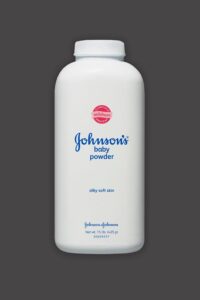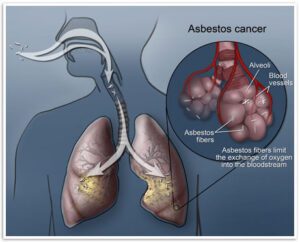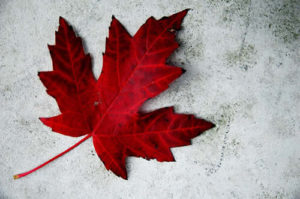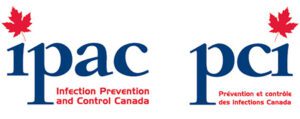Asbestos in Talc
Asbestos in Talc – What Is Talc, Where Is It Used and Why Is Asbestos a Concern?
Recently, the New York Times posted an article about asbestos in talc.
Nearly 12,000 women have sued Johnson & Johnson, with most claiming the talc in its well-known product Johnson’s Baby Powder caused their ovarian cancer. They now have a new potential legal front.


In a recent case, a group of plaintiffs argued that the talc was contaminated with asbestos, a carcinogen considered unsafe at any level of exposure. A jury agreed with them, and awarded them $4.69 billion in damages in July.
The carcinogen has been a concern inside the company for decades. In hundreds of pages of memos were recently reviewed by the New York Times executives became worried about a potential government ban of talc, the safety of the product and a public backlash over Johnson’s Baby Powder, a brand built on a reputation for trustworthiness and health.
What is talc, and why is asbestos relevant?
Talc is a mineral in clay mined from underground deposits. It’s the softest mineral known to man and that makes it useful in a wide range of consumer and industrial products.
Asbestos is also found underground, and veins of it can often be found in talc deposits, leading to a risk of cross-contamination, geologists say.
Are any other consumer products made with talc?
Talc is used in many cosmetics: lipstick, mascara, face powder, blush, eye shadow, foundation and even children’s makeup. In the list of ingredients, it can be listed as talc, talcum or talcum powder, cosmetic talc or magnesium silicate. Talc is added to cosmetics to create a silky feel and absorb moisture. Some brands make talc-free cosmetics.
Talc is also used in food processing, and to make some supplements, pharmaceutical pills, chewing gum and polished rice. Consumer groups have also found it in crayons and children’s toys, like crime-scene fingerprint kits.
Talc was routinely applied to surgical gloves and condoms until the 1990s, when the Food and Drug Administration told manufacturers to stop using it because of health concerns.
And it’s typically the primary ingredient in baby powder. Johnson’s Baby Powder is made of talc, unless the bottle says “pure cornstarch” on the front. If you’re using another brand, check the ingredients.
Should I keep talc away from my baby?
Yes. Paediatricians have been warning parents for decades not to use powder on babies because of the risk a child will inhale or aspirate talc, which can cause choking and coughing and lead to respiratory illness or chronic disease and lung damage. This has nothing to do with asbestos.
Cases of babies dying from choking on powder were reported as early as the 1960’s, and since 1981, the American Academy of Paediatrics has taken a strong position against the use of talc on babies and children, saying it is hazardous and has no medicinal value.

Is there a safe alternative?
Paediatricians suggest changing infants’ diapers frequently to prevent rashes, and recommend using an oil-based ointment when necessary, rather than using talc.
For teenagers or adults, cornstarch is a good alternative to using talc on the skin or genital area to stay dry and prevent chafing and irritation.
If it’s a product for babies, why are women suing?
Broadly speaking, the women claim that the powder caused their ovarian cancer because they used it for feminine hygiene for decades, and may have also inhaled airborne powder.
Some have argued that the talc mineral itself caused their cancer, while more recently, the claim emerged that it was asbestos contaminating the talc.
What does Johnson & Johnson say about the claims?
Johnson & Johnson has the largest share of the talcum powder market, and has been selling Baby Powder and other similar products for more than 100 years. The company says that its talc does not contain asbestos, that claims that talc causes cancer are based on bad science and that it is appealing any jury verdicts against it.
Has the F.D.A. tested talc products for asbestos recently?
The F.D.A. last tested talc products in 2010 and found no asbestos, but it was provided raw talc from only four suppliers and tested only 24 commercial products. Experts who have analysed talc on behalf of plaintiffs suing Johnson & Johnson say they have detected asbestos in talc products.
The F.D.A. does not test cosmetics for safety. With the exception of colour additives, neither makeup nor any of its ingredients require the agency’s approval. The agency says it takes the possible presence of asbestos in cosmetics very seriously, but that manufacturers and marketers are responsible for their safety.
It points to voluntary standards set by the manufacturers’ trade association, the Personal Care Products Council, which declared in 1976 that all talc products should be free of asbestos. The council has no way of enforcing the standard.


Maple Leaf Mold Inc. is a certified mold / asbestos removal and biological disinfection / air analysis company located in Toronto that uses certified IICRC technicians for all testing and remediation projects.
We are a professionally licensed firm experienced in testing, verifying and removing Mold / Asbestos / Lead and other environmental contaminants as well as providing disinfection services to control and kill biological contaminants.
Call 416-254-7256 to talk with us about your issue anytime.






